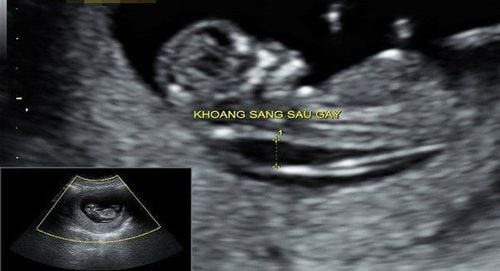This is an automatically translated article.
Fetal malformations are defects of the baby's body during the development process inside the mother's uterus, fetal malformations can appear from mild to severe, affecting the life of the fetus. young. Ultrasound is an effective method of screening for fetal malformations to help detect all abnormalities of the fetus early.
1. What is an ultrasound to screen for fetal malformations?
Congenital birth defects can originate from many causes such as genetic diseases, genetic mutations, mother's use of drugs or some diseases during pregnancy, especially in the first 3 months. Although fetal malformations are rare, they can have significant effects on the life of the child and even the life of the child after birth, depending on the severity of the defect.
Fetal ultrasound is the use of an ultrasound wave to examine the fetal organs in the mother's uterus. This method is painless, non-invasive, and there are currently no reports of adverse effects of ultrasound on a child's development during development.
Fetal malformation screening ultrasound is used to examine the abnormal changes in the structure of the fetus, from which it is possible to diagnose fetal malformations or combine with some other signs on tests to Accurately diagnose malformations.
Normally, the ultrasound scan for fetal malformation usually takes place in about 20 to 30 minutes, it can also be faster or longer for cases that are difficult to investigate due to the posture or the baby moving a lot...
2. The role of ultrasound screening for fetal malformations
With the development of science and technology in medicine, many fetal abnormalities can be detected early through prenatal screening. In which, ultrasound is a very important method to investigate fetal malformations. The role of ultrasound to screen for fetal malformations includes:
Fetal malformation ultrasound is a very safe, non-invasive, effective, easy to perform and affordable method to diagnose and monitor pregnancy. period and as well as early detection of fetal malformations at different stages, from a very early age. Fetal ultrasound under ideal conditions can accurately diagnose 85% to 90% of fetal malformations. When detecting fetal malformations, it can help guide treatment measures such as in cases of severe malformations, genetic mutations, etc., viability or intellectual disability, which may be indicated for termination of pregnancy. early to avoid burden on family and society. For mild malformations, ultrasound can monitor and evaluate malformations and prepare family members for postnatal treatment measures. Diagnostic orientation in cases of suspected chromosomal disease, such as when measuring nuchal translucency at 12 weeks is abnormal, is valuable in orienting chromosomal diseases through which in-depth tests can be done. for a definite diagnosis. However, the diagnostic value of fetal screening ultrasound depends greatly on modern equipment and machinery, the level of analytical ability of the doctor doing ultrasound, and the landmark of fetal ultrasound.

Siêu âm tầm soát dị tật thai nhi có vai trò vô cùng quan trọng
3. Fetal ultrasound landmarks to screen for fetal malformations
The fetal ultrasound in screening for fetal malformations needs to determine the appropriate ultrasound time.
Pregnancy ultrasound milestones to screen for fetal malformations include:
Fetal ultrasound in the first 3 months from about 12 weeks to 13 weeks 6 days: The ultrasound during this period helps: The fetus is developing normally, slow growth or cessation of growth in utero by determining fetal heart rate, fetal movement, and weight indicators. Number of pregnancies, single or multiple pregnancies. Detecting abnormalities in the mother's body such as: Uterine fibroids, ovarian cysts... This is the golden time for ultrasound diagnosis and screening for fetal malformations to measure the light at the nape of the neck, suspicious signs. chromosomal abnormalities. Detect some early malformations: Intracranial pregnancy, spinal cleft, umbilical hernia, abdominal wall cleft... Ultrasound in the second trimester of pregnancy at about 18 to 22 weeks: During this period can be survey 80% of fetal morphological abnormalities, detect birth defects such as ultrasound to detect birth defects in fetal morphology, from which identification measures such as amniocentesis can be applied. amniotic fluid under ultrasound in high-risk cases. Some malformations are identified in this stage such as: neural tube defects, Down syndrome, anencephaly, abdominal wall defect, cleft lip, umbilical hernia, stillbirth... If the ultrasound results and the Additional tests identify children with severe malformations, with indications for termination of pregnancy. Uterine length determination assesses the risk status of preterm birth. Fetal ultrasound in the last 3 months of pregnancy is from 30 to 32 weeks: During this period, ultrasound continues to diagnose fetal malformations and can detect some abnormalities that appear late in the development process such as abnormality in pregnancy. arteries, the heart, inside the brain. In addition, it helps to assess the prognosis of the delivery and the health status of the fetus. Fetal malformations are not common, but they seriously affect the development of the baby after birth. Therefore, early identification of fetal malformations helps determine the status to prepare for the postpartum process and reduce pressure on the family. However, in order to achieve optimal efficiency, modern machinery is required and it is important that the operator has experience, good coordination and analysis ability. Therefore, it is advisable to choose reputable establishments to be able to be performed in the most accurate way.

Siêu âm tầm soát dị tật thai nhi cần được thực hiện tại cơ sở y tế uy tín
In addition, to protect mother and baby during pregnancy, Vinmec provides a package Maternity service to help monitor the health status of mother and baby comprehensively, periodically check antenatal care with leading obstetricians and gynecologists. , perform a full range of tests, important screening for pregnant women, timely advice and intervention when detecting abnormalities in the health of mother and baby.
Please dial HOTLINE for more information or register for an appointment HERE. Download MyVinmec app to make appointments faster and to manage your bookings easily.













